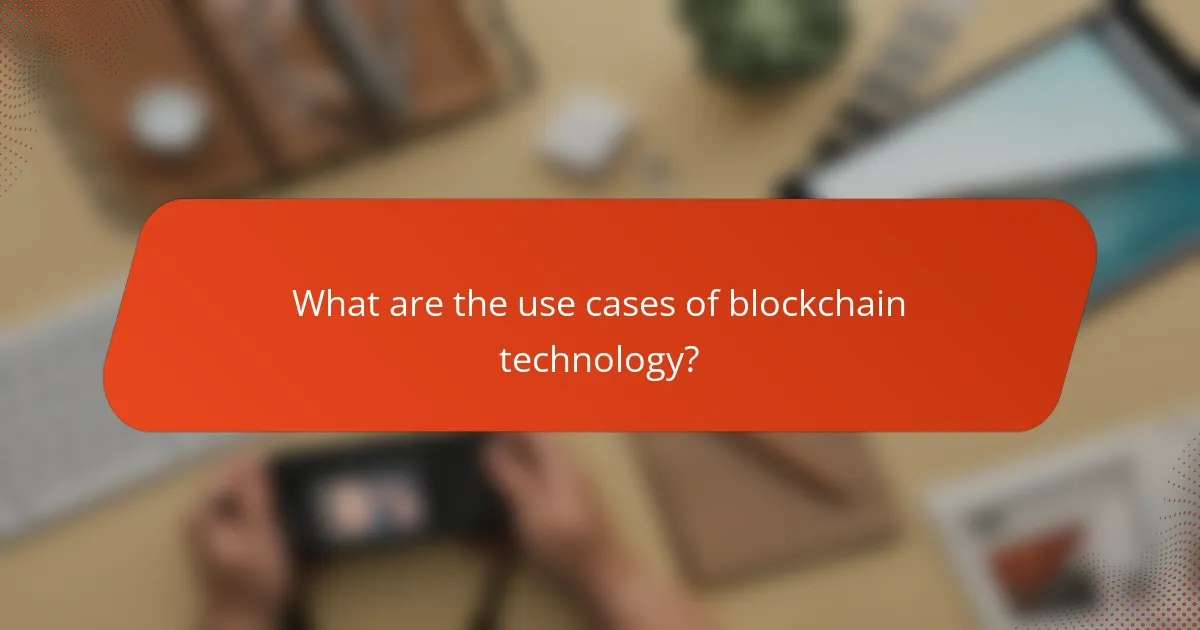Blockchain is a decentralized digital ledger technology that provides secure, transparent, and tamper-proof record-keeping across various applications beyond cryptocurrency. This article explores the diverse use cases of blockchain in industries such as supply chain management, healthcare, voting systems, intellectual property, finance, real estate, and digital identity verification. It highlights the key security features of blockchain, including decentralization, cryptography, immutability, transparency, and consensus mechanisms, which collectively enhance trust and efficiency. The discussion underscores how blockchain technology can significantly improve processes and security across multiple sectors.

What is Blockchain Beyond Cryptocurrency?
Blockchain is a decentralized digital ledger technology that extends beyond cryptocurrency. It enables secure, transparent, and tamper-proof record-keeping across various applications. Industries such as supply chain management use blockchain to enhance traceability and accountability. Healthcare leverages blockchain for secure patient data sharing and management. Voting systems benefit from blockchain’s ability to ensure transparency and reduce fraud. Additionally, intellectual property rights can be managed more effectively using blockchain for ownership verification. Each of these applications demonstrates how blockchain technology can improve efficiency and security across multiple sectors.
How does blockchain technology function outside of cryptocurrency?
Blockchain technology functions outside of cryptocurrency by enabling secure and transparent data management across various sectors. It allows for decentralized record-keeping, which enhances trust among participants. For example, in supply chain management, blockchain tracks products from origin to consumer, ensuring authenticity and reducing fraud. In healthcare, it securely shares patient records among authorized providers, improving care coordination. Smart contracts automate processes in industries like real estate, reducing the need for intermediaries. Additionally, blockchain supports digital identity verification, enhancing security against identity theft. These applications demonstrate blockchain’s versatility beyond financial transactions.
What are the core principles of blockchain technology?
The core principles of blockchain technology include decentralization, transparency, immutability, and security. Decentralization means that no single entity controls the entire network. This reduces the risk of failure or manipulation. Transparency allows all participants to view transaction history. This builds trust among users. Immutability ensures that once data is recorded, it cannot be altered. This protects the integrity of the information. Security is achieved through cryptographic techniques. These techniques secure transactions and user identities. Together, these principles create a robust framework for various applications beyond cryptocurrency.
How does decentralization enhance blockchain applications?
Decentralization enhances blockchain applications by distributing control among multiple participants. This reduces the risk of a single point of failure. It increases transparency as all transactions are recorded on a public ledger. Users can verify transactions independently, fostering trust. Additionally, decentralization improves security by making it harder for malicious actors to manipulate the system. According to a 2021 report by the World Economic Forum, decentralized systems can reduce fraud and increase resilience. These factors contribute to the broader adoption of blockchain across various industries.
What are the key attributes of blockchain technology?
The key attributes of blockchain technology include decentralization, transparency, security, immutability, and consensus mechanisms. Decentralization means that no single entity controls the entire network. This reduces the risk of failure or manipulation. Transparency allows all participants to view transaction histories. This fosters trust among users. Security is enhanced through cryptographic techniques, making it difficult for unauthorized users to alter data. Immutability ensures that once a transaction is recorded, it cannot be changed or deleted. This builds a reliable history of transactions. Consensus mechanisms, like Proof of Work or Proof of Stake, validate transactions. They ensure agreement among participants before adding data to the blockchain. These attributes collectively enhance the reliability and usability of blockchain technology.
What makes blockchain secure compared to traditional systems?
Blockchain is secure compared to traditional systems due to its decentralized nature. In a blockchain, data is stored across a network of computers, making it difficult for any single entity to alter the information. Each block in the chain contains a cryptographic hash of the previous block, which links them together. This ensures that any attempt to change a block would require altering all subsequent blocks, a task that is computationally impractical. Additionally, blockchain employs consensus mechanisms like Proof of Work or Proof of Stake, which require agreement from multiple participants before transactions are validated. This adds another layer of security against fraudulent activities. In contrast, traditional systems often rely on a central authority, making them more vulnerable to hacks and data breaches. According to a study by IBM, 95% of cybersecurity breaches are due to human error, highlighting the risks associated with centralized control. Thus, the combination of decentralization, cryptographic linking, and consensus mechanisms makes blockchain inherently more secure than traditional systems.
How does transparency benefit blockchain applications?
Transparency enhances blockchain applications by ensuring data integrity and trust among users. It allows all participants to access and verify transactions in real-time. This visibility reduces the potential for fraud and manipulation. Users can trace the history of transactions, promoting accountability. According to a study by the World Economic Forum, transparency in blockchain can increase trust in digital transactions by up to 70%. This trust fosters wider adoption across industries. Enhanced transparency also streamlines processes by reducing the need for intermediaries. Overall, transparency is a crucial attribute that strengthens the reliability of blockchain systems.

What are the use cases of blockchain technology?
Blockchain technology has several use cases across various industries. Supply chain management benefits from enhanced transparency and traceability. In finance, blockchain enables secure and efficient cross-border payments. Healthcare utilizes blockchain for secure patient data sharing and management. Voting systems can leverage blockchain for tamper-proof election processes. Intellectual property rights are protected through blockchain by providing a clear ownership record. Real estate transactions become more efficient with blockchain by streamlining property transfers. Additionally, digital identity verification is improved through blockchain, reducing fraud and enhancing security. These use cases demonstrate the versatility and potential of blockchain technology in diverse sectors.
How is blockchain being utilized in various industries?
Blockchain is being utilized in various industries to enhance transparency, security, and efficiency. In supply chain management, blockchain provides real-time tracking of goods. This reduces fraud and improves accountability among stakeholders. In healthcare, blockchain secures patient records and ensures data integrity. A study by the World Health Organization highlights its potential to streamline health information exchange. In finance, blockchain facilitates faster and cheaper cross-border transactions. According to a report by Deloitte, this can reduce transaction costs by up to 40%. The real estate sector benefits from blockchain by simplifying property transactions and reducing paperwork. Additionally, the voting process can be made more secure and transparent through blockchain technology. These applications demonstrate the versatility of blockchain across multiple industries.
What are the applications of blockchain in supply chain management?
Blockchain has several applications in supply chain management. It enhances traceability by providing a transparent ledger of transactions. This transparency allows all parties to verify the origin and journey of products. Smart contracts automate processes, reducing delays and errors. They execute automatically when predefined conditions are met. Blockchain also improves security by encrypting data, making it tamper-proof. This reduces the risk of fraud and counterfeiting. Additionally, it facilitates collaboration among stakeholders by ensuring all have access to the same information. According to a report by the World Economic Forum, blockchain could reduce supply chain costs by up to 20%.
How is blockchain transforming the healthcare sector?
Blockchain is transforming the healthcare sector by enhancing data security and interoperability. It allows for secure sharing of patient records among healthcare providers. This technology reduces the risk of data breaches, as it employs cryptographic techniques. Additionally, blockchain facilitates real-time access to patient information, improving care coordination. A study by the World Economic Forum highlights that 80% of healthcare organizations see blockchain as beneficial for data management. By ensuring data integrity, blockchain can streamline processes like clinical trials and drug supply chains. The adoption of blockchain can lead to cost savings and increased efficiency in healthcare operations.
What innovative use cases are emerging in blockchain technology?
Innovative use cases emerging in blockchain technology include supply chain management, digital identity verification, and decentralized finance (DeFi). Supply chain management uses blockchain for real-time tracking of goods. This enhances transparency and reduces fraud. Digital identity verification leverages blockchain to secure personal data. It allows users to control their identities without relying on centralized authorities. Decentralized finance (DeFi) offers financial services without intermediaries. It enables peer-to-peer lending and borrowing through smart contracts. Other use cases include healthcare data management and voting systems. These applications improve security and efficiency in their respective fields.
How does blockchain enhance digital identity verification?
Blockchain enhances digital identity verification by providing a secure and decentralized method for storing and managing identity data. This technology allows individuals to control their own identity information without relying on central authorities. Each identity is represented by a unique cryptographic key, ensuring authenticity and preventing unauthorized access. Transactions involving identity data are recorded on an immutable ledger, making it difficult to alter or forge identities. According to a 2021 report by the World Economic Forum, blockchain can reduce identity fraud by up to 80%. Additionally, blockchain’s transparency allows for real-time verification, increasing trust among parties involved. This combination of security, control, and transparency significantly improves the integrity of digital identity verification processes.
What role does blockchain play in smart contracts?
Blockchain serves as the foundational technology for smart contracts. It provides a decentralized and immutable ledger for recording contract terms. This ensures that once a smart contract is deployed, it cannot be altered or tampered with. Blockchain enables automatic execution of contract terms when predefined conditions are met. This reduces the need for intermediaries, streamlining processes and lowering costs. Additionally, transactions on the blockchain are transparent and verifiable, enhancing trust among parties. The use of blockchain in smart contracts has been validated by real-world applications across various industries, including finance and supply chain management.

What security features does blockchain offer?
Blockchain offers several key security features. Firstly, it utilizes decentralization to eliminate a single point of failure. This structure enhances resilience against attacks. Secondly, blockchain employs cryptography for secure transactions. Each transaction is encrypted and linked to previous ones. Thirdly, it includes immutability, meaning once data is recorded, it cannot be altered. This feature prevents tampering and fraud. Additionally, blockchain provides transparency through a public ledger. All participants can verify and audit transactions. Finally, consensus mechanisms, like Proof of Work or Proof of Stake, ensure agreement among network participants. This prevents malicious activities and enhances trust. These features collectively make blockchain a secure technology for various applications.
How does blockchain ensure data integrity and security?
Blockchain ensures data integrity and security through its decentralized and immutable nature. Each block in a blockchain contains a cryptographic hash of the previous block, creating a secure chain. This structure prevents unauthorized alterations to data. Transactions are verified by a consensus mechanism, which requires agreement among network participants. As a result, fraudulent activities are significantly reduced. The use of public and private keys enhances security by ensuring that only authorized users can access or modify data. Additionally, the transparency of blockchain allows for real-time auditing, further reinforcing trust in the system. This combination of features makes blockchain a robust solution for maintaining data integrity and security across various applications.
What cryptographic techniques are used in blockchain?
Blockchain employs several cryptographic techniques to ensure security and integrity. The primary technique is hashing, which converts data into a fixed-size string of characters. This process makes it nearly impossible to reverse-engineer the original data. Another crucial technique is public-key cryptography. It uses a pair of keys, one public and one private, to facilitate secure transactions. Digital signatures are also utilized to authenticate transactions and verify the identity of users. These signatures ensure that the sender cannot deny sending the transaction. Additionally, Merkle trees are used to efficiently organize and verify large amounts of data. They enhance data integrity by allowing quick verification of individual transactions within a block. These cryptographic methods collectively protect blockchain networks from fraud and unauthorized access.
How does consensus mechanism contribute to security?
A consensus mechanism enhances security by ensuring that all participants in a blockchain network agree on the validity of transactions. This agreement prevents malicious actors from altering transaction history. It requires a majority of network nodes to validate new blocks, which deters attacks. For example, in Proof of Work, miners must solve complex puzzles, making it costly to attack the network. In Proof of Stake, validators are financially incentivized to act honestly. Research shows that networks with robust consensus mechanisms experience fewer security breaches. Overall, consensus mechanisms create a trustworthy environment for data integrity in blockchain systems.
What are the challenges related to blockchain security?
Blockchain security faces several challenges. One key challenge is the susceptibility to 51% attacks. In such attacks, a single entity gains control of the majority of the network’s mining power. This can lead to double-spending and transaction manipulation.
Another challenge is the presence of smart contract vulnerabilities. Flaws in smart contract code can be exploited, resulting in financial losses. High-profile incidents, such as the DAO hack, highlight these risks.
Additionally, user error poses a significant security threat. Mistakes in managing private keys can lead to irreversible loss of assets. Phishing attacks targeting users further compound this issue.
Regulatory uncertainty also impacts blockchain security. Lack of clear regulations can lead to inconsistent security practices across different jurisdictions. This can create vulnerabilities that malicious actors may exploit.
Finally, scalability issues can affect security. As networks grow, maintaining security while ensuring performance becomes increasingly difficult. This can lead to compromises that weaken the overall integrity of the blockchain.
How can vulnerabilities in blockchain be mitigated?
Vulnerabilities in blockchain can be mitigated through several strategies. Implementing robust consensus mechanisms enhances security against attacks. Regular audits of smart contracts can identify and rectify potential flaws. Utilizing multi-signature wallets provides an additional layer of protection. Employing encryption techniques secures data integrity and privacy. Educating users about phishing and social engineering threats reduces human errors. According to a 2021 report by the World Economic Forum, 90% of blockchain vulnerabilities can be addressed through these best practices.
What are common security threats to blockchain networks?
Common security threats to blockchain networks include 51% attacks, smart contract vulnerabilities, and phishing attacks. In a 51% attack, a group controls the majority of the network’s mining power. This allows them to manipulate transactions and double-spend coins. Smart contract vulnerabilities arise from coding errors that can be exploited. For example, the DAO hack in 2016 resulted in a loss of $60 million due to such vulnerabilities. Phishing attacks target users to steal private keys or credentials. These threats highlight the importance of robust security measures in blockchain technology.
How can organizations adopt blockchain technology effectively?
Organizations can adopt blockchain technology effectively by following a structured approach. First, they should identify specific use cases that align with their business goals. This could involve supply chain management, secure transactions, or data integrity. Next, they must evaluate the right blockchain platform that suits their needs. Popular options include Ethereum, Hyperledger, and Corda.
Training employees on blockchain fundamentals is crucial for successful implementation. This ensures that staff understands the technology and its implications. Organizations should also collaborate with blockchain experts to guide the integration process.
Pilot projects can help test blockchain applications on a smaller scale. This allows organizations to assess performance and scalability before full deployment. Finally, organizations must ensure compliance with regulations governing blockchain use.
According to a Deloitte report, 39% of organizations are exploring blockchain for operational efficiency. This statistic highlights the growing interest in blockchain adoption across various sectors.
What best practices should organizations follow for successful blockchain implementation?
Organizations should follow several best practices for successful blockchain implementation. First, they must define clear objectives for their blockchain project. This ensures alignment with business goals. Second, organizations should assess the right blockchain technology for their needs. Different platforms offer various features and scalability options. Third, they need to engage stakeholders early in the process. This fosters collaboration and gathers diverse insights.
Fourth, organizations should prioritize security measures. Blockchain is inherently secure, but additional safeguards enhance protection. Fifth, they must ensure regulatory compliance. Adhering to legal frameworks prevents future complications. Finally, organizations should invest in training and education. Knowledgeable teams are crucial for effective implementation and ongoing management. These best practices establish a solid foundation for successful blockchain initiatives.
Blockchain is a decentralized digital ledger technology that extends beyond cryptocurrency, enabling secure and transparent record-keeping across various sectors. This article explores the diverse use cases of blockchain in industries such as supply chain management, healthcare, and finance, highlighting its potential to enhance efficiency and security. Key attributes of blockchain, including decentralization, transparency, and immutability, are discussed, along with the security features that make it more robust than traditional systems. Additionally, the article addresses challenges related to blockchain security and outlines best practices for effective implementation and adoption in organizations.




